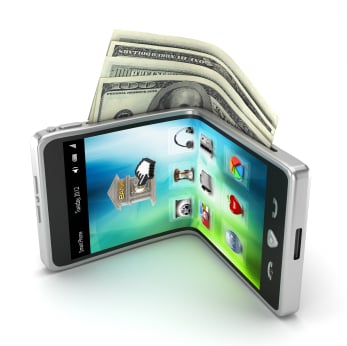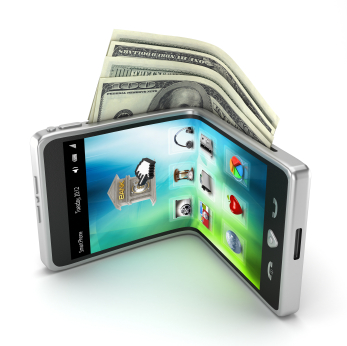More than Just Talk: How Mobile Powers Online Billing and Payment
November 19, 2012 •Brian Watson

 Americans are seriously enamored with their mobile devices.
Americans are seriously enamored with their mobile devices.
That’s the chief takeaway from the most recent report from the Pew Internet and American Life Project, published in September of this year. A robust 85% of the adult Americans Pew surveyed for the project report owning a cellular phone of some kind.
That’s a lot of phones. Millions and millions to be more precise. And yet it’s probably not a figure that’s especially surprising or noteworthy to you. After all, if you’re like most Americans, your cell phone of choice is probably a fundamental part of your daily routine.
Today’s consumers are not only increasingly likely to own a mobile phone. They also tend to use it to for far more than just calls – communicating via text and email, browsing the web, and using apps to connect socially and manage day-to-day tasks.
For example, the average cell phone owner sends 41.5 text messages a day. Sixteen percent of email messages were viewed using a mobile device. Thirty-eight percent of all daily media interactions take place on a mobile device. And 33% of consumers have made a payment using their mobile device.
In short: mobile communication is a pretty big deal. And that trend has all sorts of far-reaching consequences. But for online billing and payment, the upshot is remarkably simple: if you want to reach the highest number of consumers and collect the most revenue possible, mobile better be a part of your game plan.
How does the mobile pay process work? And what tools do you need to know about before green-lighting a mobile-based strategy?
The Foundation: IVR Phone Payment
IVR (or Interactive Voice Response) is not exactly a new technology. It’s been a popular call-center option since the late 1990s. But with the rise in mobile coinciding with sleek new voice recognition software, IVR is quickly becoming an important tool for customer revenue collection.
In essence, IVR is pay-by-phone technology that uses voice or key tone recognition to provide customers with a simple, flexible payment option.
The real benefit of the technology is the anytime, anywhere payment flexibility it provides. With IVR, customers can easily make a phone-based payment after you’ve closed up shop for the day.
It’s also a business office efficiency booster. Payment automation helps reduce your staff’s work load, eliminate manual payment processing errors, and lower the total number of customer calls you field.
The Upgrade: Mobile Payment
IVR technology is great for you. Those automation advantages I just described go a long way towards reducing collection costs and streamlining revenue cycle operations.
And - due to its flexibility - it’s also really good for your customers. The “always on” benefit sounds simple, but can really pay dividends with customers who don’t have the time or opportunity to make a phone payment during normal business hours.
But it also has some pretty glaring limitations; limitations that do a good job of explaining why it’s been a hit with call-centers for years, but still isn’t a must-have revenue cycle tool. For one, customers still like to talk to a service rep when they phone a call center. A 2011 Consumer Reports survey reported 71% of respondents were “annoyed” at not being able to reach a human on the phone.
Today’s mobile payment technology was created with that hard truth in mind. IVR phone technology is still the foundation. But sleek new mobile-phone-specific tools make the process faster, easier, and more flexible.
For example, best-practice mobile payment systems now enable customers to receive payment alerts directly to their mobile phone. What’s more, the customer can then take action on the bill right from the device - easily scheduling or authorizing a payment to pay the bill. Often in as little as one key stroke.
Common mobile notification and payment techniques include:
• Outbound IVR. Automated voice messages with key payment details are delivered to the cellular devices your customers authorize during mobile pay enrollment. At the end of the call, customers can easily authorize payment - either by confirming a previously established funding source (with a single key click) or by using an IVR system to provide payment information.
• SMS with IVR. A text-message based application, SMS with IVR sends a simple SMS with summary details of the customer’s payment to their authorized mobile device. Included with the billing summary is a phone number that they can use to call in and authorize payment using an IVR voice payment system.
The Game-Changer: Mobile Web
IVR and mobile payment are both valuable precisely because they’re technologies built to embrace and leverage the ever-expanding state of cell phone ownership among Americans.
The 85% of American adults who own some kind of cell phone is more than the 80% that regularly use the Internet or 72% with in-home web access (according to a 2011 report from the U.S. Department of Commerce).
That makes both those technologies critical in the here-and-now. But future viability and customer adoption of mobile payment hinges on the intersection of cellular devices and web browsers. In other words, the smartphone.
Pew pegs smartphone ownership at an impressive 45% of adult Americans. And it’s growing quickly (up 10% since May 2011). Emerging mobile payment technology is all about using the enhanced web and app connectivity offered by smartphones to make the payment process that much easier.
Promising smartphone-specific mobile technology includes:
• Mobile-Optimized Pay Sites. Websites designed for full-service Internet browsers often translate poorly to a mobile device. Mobile-optimized websites, on the other hand, are created specifically with the small-screen in mind. Mobile detection automatically identifies cellular users so that the website shown is device-appropriate. And, to ensure a customer-friendly EBPP experience, navigation is simple, balance and payment information is front-and-center, forms are mobile-optimized, and links and buttons are finger-friendly.
• SMS with Browser. SMS with browser is similar to SMS with IVR. Except when customers receive a text message summary of payment details to their cellular phone, a short-form browser link is included. When clicked, those links take customers to a mobile-optimized version of your web page to authorize payment.
• Mobile Payment Application. The ultimate in phone-based EBPP technology, mobile payment applications enable bill access and balance payment from a self-contained app stored on the customer’s smartphone. Similar to the kind of app sold on Apple’s mobile storefront, these free programs are built specifically for smartphones. That means they offer all the value-added tools of full EBPP websites - like account management, online help, funds management – but in a mobile-optimized format.
Ready to dive into the world of mobile-payment, but not quite sure where to start? We’re more than happy to provide a helping hand. To learn more about the ins-and-outs of mobile EBPP technology, click here to shoot us an email or schedule a time to talk.
Get Updates
Featured Articles
Categories
- Charity Care Management (1)
- Compliance (2)
- Customer Service (8)
- Digital Front Door (1)
- Direct Mail (6)
- eBilling (1)
- EBPP (34)
- ESL Statement (2)
- eStatement (1)
- Healthcare Channel Partner Billing (1)
- IVR (3)
- Mobile Payment (11)
- Online Billing and Payment (6)
- Online Patient Payment (17)
- Outsource Print Management (4)
- Paperless Billing (4)
- Patient Engagement (2)
- Patient Friendly Billing (21)
- Print and Mail (7)
- QR Codes (1)
- Quick Pay (7)
- Security (1)
- Self-Pay Patients (9)
- Self-Pay Revenue (4)
- Statement Design (32)
- Statement Print and Mail (1)
- Statement Printing and Mailing (28)
- Statement Processing (36)
- TransPromo (1)
- Up-Front Billing (1)

